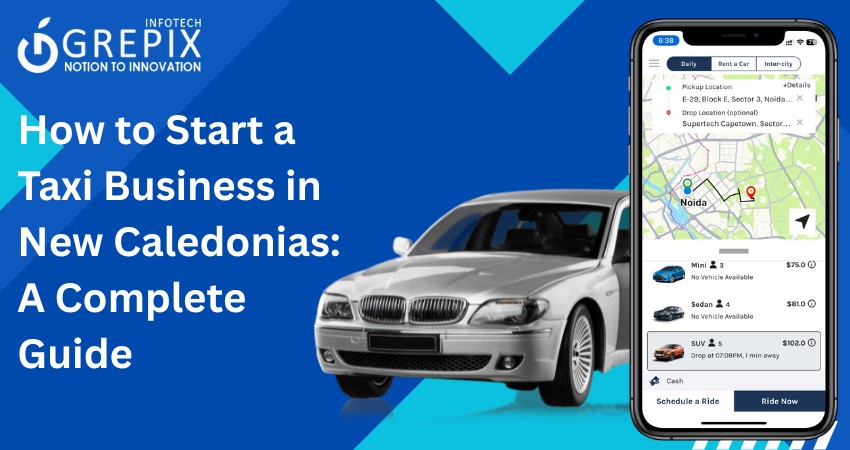How to Start a Taxi Business in New Caledonia: A Complete Guide
Starting a taxi business in New Caledonia offers a promising opportunity due to the region’s growing tourism and demand for reliable transportation. This complete guide outlines the key steps to get started. First, conduct thorough market research to understand local demand, competition (e.g., existing taxis and services like JB Transport), and customer preferences in areas like Nouméa or tourist-heavy islands. Next, create a solid business plan detailing your budget, target market, and operational strategy consider whether you’ll focus on airport shuttles, island transfers, or urban rides.
Register your business with local authorities, such as the New Caledonian government, and secure necessary permits, including a taxi operator’s license and vehicle compliance certificates. Invest in a suitable vehicle fuel-efficient and comfortable options like a Toyota Corolla work well and equip it with a meter, GPS, and safety features. Obtain comprehensive insurance to cover liabilities and accidents, as mandated by local regulations.
Leverage technology by offering online bookings or partnering with platforms like Coconut Taxi Boat for broader reach. Market your services through social media, local tourism boards, and word-of-mouth, emphasizing reliability and affordability (e.g., competitive rates like 127 XPF per km). Finally, ensure regular vehicle maintenance and excellent customer service to build a loyal clientele in this vibrant Pacific market. With careful planning and execution, your taxi business can thrive in New Caledonia’s unique landscape.
Starting a taxi business in New Caledonia offers immense potential due to its growing urban centers and thriving tourism. This comprehensive guide walks aspiring entrepreneurs through every step, from legal registration, business planning, and vehicle procurement to driver recruitment, safety compliance, and marketing strategies. A modern taxi operation must be powered by technology, and Grepix Infotech provides the ideal solution with its white-label taxi app software. Their platform includes robust features for passengers, drivers, and admin management enabling real-time tracking, seamless payments, and full control over operations. With fast deployment, full customization, and lifetime support, Grepix ensures a hassle-free launch for your taxi business. Whether you aim to start small or scale a full fleet, their solution offers flexibility, affordability, and scalability. By combining strategic planning with Grepix’s digital tools, entrepreneurs can build a successful, tech-driven taxi service that meets the modern demands of New Caledonian riders.
1 Introduction
Thinking about launching a taxi business in New Caledonia? You're onto something big. With its unique blend of tropical beauty, thriving tourism, and a growing urban population, New Caledonia is an untapped market for smart entrepreneurs looking to enter the transportation industry.
Over the past decade, the way people move from place to place has changed dramatically. Gone are the days when people waited endlessly for a cab. Today, convenience is king and digital solutions like ride-hailing apps are ruling the throne. Mobile-first transportation options are now not just preferred, they’re expected.
So, how do you set up a taxi business that meets this demand, especially if you're just starting? That’s what this complete guide is all about. We’ll walk you through every step you need to take from the idea stage to your first ride and show how Grepix Infotech can be the turbocharger your business needs. Whether you're launching solo or aiming to build a fleet, there’s a blueprint here for you. Let’s dive into how you can not just start, but thrive, in the New Caledonian taxi business market.
2 Why Start a Taxi Business in New Caledonia?
New Caledonia might be a small island territory, but it's buzzing with potential. Nestled in the South Pacific, it attracts thousands of tourists annually while also supporting a local population that increasingly demands efficient transport services.
Currently, many parts of the island still depend on outdated transport methods. Public transport options are limited, especially in remote and suburban regions. That gap creates a golden opportunity for taxi entrepreneurs.
Let’s break it down:
- Tourist Boom: New Caledonia is a hotspot for tourists seeking picturesque beaches, coral reefs, and French-inspired culture. These travelers need reliable transport from airports, hotels, and local attractions.
- Urban Growth: Urban centers like Nouméa are growing. As more businesses and residences pop up, so does the need for accessible taxi services.
- Digital Readiness: Smartphone penetration is on the rise. Residents and tourists alike prefer using mobile apps for services—including transportation.
- Economic Support: The government has been open to small business initiatives and is welcoming new players in sectors like tech and transport.
This combination of need, opportunity, and readiness makes New Caledonia a promising location for launching a profitable taxi business—especially one powered by modern, tech-savvy solutions.
3 Understanding the Legal Framework
Before you can hit the road, you need to understand the rules that govern taxi operations in New Caledonia. This step is crucial to ensure that your business stays on the right side of the law from day one.
Here’s what you’ll need to sort out:
Business Registration
Start by registering your company with the relevant New Caledonian authority. Whether you’re forming a sole proprietorship, partnership, or limited company, proper registration is the first official step.
Taxi Operation License
You’ll need to obtain a taxi operator’s license. This includes:
- Vehicle roadworthiness checks
- Compliance with environmental standards
- Proof of business insurance
- Driver background clearance
The licensing body might also place limits on the number of vehicles you can operate initially, so plan accordingly.
Tax and Financial Regulations
Register for tax identification and set up proper accounting channels. Depending on your structure, you may be liable for corporate income tax, VAT, and employee contributions.
Insurance and Safety
A commercial vehicle insurance policy is mandatory. In addition, drivers need personal liability coverage, and your fleet must meet the safety regulations laid out by local transport authorities.
Skipping these legal steps can result in delays, fines, or worse getting shut down. That’s why many smart entrepreneurs partner with experienced solution providers like Grepix Infotech, who not only offer the tech but can also advise on launching legally and effectively.
4 Creating a Business Plan
This is where your taxi dream turns into a real business vision. A well-crafted business plan isn’t just for investors, it’s your roadmap to success.
Budgeting and Financing
Start by listing your startup costs:
- Vehicle procurement or lease
- App development or licensing
- Driver salaries or commissions
- Office space (if needed)
- Legal and insurance fees
Then, determine your funding source: personal savings, bank loans, grants, or investors.
Market Research
Know your competition. How many taxi operators already exist in your target region? What pricing models do they follow? Are customers satisfied?
Your goal is to identify gaps in the service you can fill like app-based convenience, multilingual drivers for tourists, or luxury vehicles for corporate clients.
Revenue Projections
Estimate your monthly earnings based on:
- Average ride fare
- Number of rides per day
- Operational costs
This will help you identify your break-even point and future profit margins.
Goal Setting
Set measurable objectives:
- Launch date
- Number of rides in the first month
- Customer retention goals
- Marketing targets
A strong business plan can also make it easier to convince investors or financial institutions to support your startup.
5 Choosing the Right Business Model
Every taxi startup needs a clear structure. Your business model shapes everything from operations to profitability. Here are the most common ones:
Traditional Model
In this model, you operate a fleet of taxis managed from a central office. Drivers are hired on salary or commission. While this gives you full control, it requires significant capital and staff.
Aggregator/App-Based Model
This tech-savvy approach involves creating a platform where independent drivers can register and pick up rides through your app. It’s cost-effective, scalable, and aligns with customer expectations.
Grepix Infotech specializes in these kinds of platforms. Their ready-to-deploy taxi app lets you become an Uber-style service provider in your city without the Uber-sized price tag.
Hybrid Model
You can also combine both. Own part of the fleet and allow freelance drivers to join your platform. It gives you control and flexibility, allowing faster market penetration and service diversification.
6 Procuring Vehicles for the Fleet
Once your business model is set, it’s time to think about the heart of your taxi business your vehicles. Your choice here can make or break the customer experience. Think about it would you want to ride in a noisy, worn-out car or a clean, modern, well-maintained vehicle?
Buying vs Leasing
Buying your fleet gives you full ownership and long-term cost savings. However, it requires significant upfront capital. On the flip side, leasing gives you access to newer models with less initial investment, making it perfect for startups testing the waters.
- Buying Advantages: No monthly rental payments, complete control over branding and modifications.
- Leasing Advantages: Lower entry cost, easy vehicle replacement, maintenance often included.
Evaluate your startup capital and long-term plan before deciding which works for you.
Recommended Car Models for Taxis in New Caledonia
Given the island’s diverse terrain and tourist-heavy routes, you’ll want vehicles that offer:
- Fuel efficiency: Saves on operating costs.
- Spacious interiors: Ideal for group travel or airport runs.
- Durability: Can handle both city and semi-rural roads.
Popular options include Toyota Prius, Hyundai i10 or Creta, Kia Seltos, and Toyota Innova for larger groups.
Branding and Customization
To build brand recognition and ensure trust:
- Add your logo, colors, and contact info to every vehicle.
- Equip them with modern GPS, fare meters, and safety cameras.
- Ensure interior cleanliness and amenities like phone charging or water bottles.
Presentation matters. First impressions often determine if a passenger will become a repeat customer.
7 Hiring Drivers and Building a Team
Your drivers are the face of your business. A courteous, professional driver can create loyal customers, while a rude or unsafe one can wreck your brand. Let’s break down how to build a winning team.
Driver Qualifications and Licensing
In New Caledonia, taxi drivers must meet certain legal standards:
- Valid driver’s license for commercial vehicles.
- Clean driving record.
- Local area knowledge (especially important for tourists).
You may also want to include language skills, especially French and English fluency, depending on your clientele.
Background Checks and Training
Background checks are non-negotiable. You’re placing customer safety in their hands. Use government databases or hire third-party services for criminal and driving history screening.
Once cleared, provide in-house training on:
- Customer service etiquette
- App usage (if using Grepix Infotech’s system)
- Emergency response protocols
- Hygiene and vehicle maintenance
Contractor vs Employee Model
- Contractor Model: Drivers operate their own vehicles under your platform (popular with app-based models). Less overhead but less control.
- Employee Model: You own the cars and employ drivers. More control, but higher costs due to salaries and benefits.
Choose based on your scale, goals, and local labor laws.
The stronger your team, the smoother your operations and the more customers will keep coming back.
8 Taxi Insurance and Safety Requirements
Insurance and safety aren't just regulatory checkboxes, they’re lifelines for your business. One accident or incident can cost thousands, or worse, damage your reputation permanently. Here’s how to protect your business, your drivers, and your passengers.
Types of Insurance Needed
- Commercial Vehicle Insurance: Covers your car in case of damage, theft, or accident.
- Third-Party Liability: Mandatory in most regions, it covers injuries or damage to third parties.
- Driver and Passenger Insurance: Protects everyone inside the car in case of accidents.
- Comprehensive Fleet Insurance: If you’re running multiple vehicles, get a package deal for better rates.
Speak to a local insurance advisor in New Caledonia who understands taxi-specific risks.
Safety Compliance and Standards
Ensure all vehicles are:
- Fitted with seat belts for every passenger
- Equipped with GPS tracking (included in Grepix’s software)
- Routinely serviced and checked
- Stocked with first aid kits and emergency tools
You’ll also want a 24/7 helpline in case of emergencies. Grepix’s admin dashboard allows real-time monitoring of each ride, helping you quickly intervene when needed.
Digital Safety Measures
- Panic buttons for drivers and passengers
- Ride-sharing details shared with friends or family
- Real-time route sharing and driver identification
The more secure your system, the more trust you build—and trust translates directly into customer loyalty.
9Leveraging Technology for Taxi Operations
We live in a world where technology drives everything. For taxi businesses, going digital isn’t just an option, it’s essential. It helps you streamline operations, satisfy customers, and outpace the competition.
Why Go Digital?
Let’s face it, no one wants to call a taxi dispatcher anymore. Passengers want an app where they can:
- Book a ride in seconds
- Track the driver’s location
- Pay online
- Rate their experience
A digital approach also lets you analyze business metrics, automate bookings, and expand easily.
Core Technologies to Include
Here’s what your digital system needs to be competitive:
- Ride Booking App (iOS and Android): For passengers to book, pay, and rate.
- Driver App: For receiving trip requests, tracking earnings, and navigation.
- Admin Dashboard: To manage users, trips, drivers, and finances in one place.
Importance of Real-Time Features
Real-time GPS tracking, live fare calculation, surge pricing, and in-app chat support give your service a competitive edge. Grepix Infotech provides all of this out of the box.
Their white-label solution allows you to launch a branded taxi app in record time fully customized for the New Caledonian market.
Also Read: "Accelerating Your Fortune: Becoming a Billionaire in South Africa's Taxi Industry"
10 Why Choose Grepix Infotech for Your Taxi App?
When it comes to launching a digital taxi service, the technology behind it is your engine. And if you want that engine to run smoothly, you need the right tech partner. That’s where Grepix Infotech comes in.
Industry Expertise
Grepix Infotech has delivered taxi solutions to over 50+ countries, each with unique legal and market dynamics. They know the industry inside out and understand the challenges of startups in emerging markets like New Caledonia.
Fast Deployment
Why spend 6 months building an app from scratch when Grepix can launch your branded platform in under 10 days? You get:
- A branded app in your company’s name
- Complete driver and rider apps
- A powerful admin dashboard
Customization Options
Whether you want unique payment options, multilingual support (hello, French and English), or special driver verification flows, Grepix has you covered. You’ll get:
- A fully white-labeled solution
- 100% source code ownership
- Lifetime technical support
Cost-Effective Packages
They offer tiered pricing based on your business size. Whether you’re launching with 5 cars or 50, there’s a plan to fit your budget.
Grepix doesn’t just provide the app they become your launch partner, making it easy to go from planning to live rides without tech headaches.
11 Key Features of Grepix’s Taxi App Software
The success of your taxi business in New Caledonia heavily depends on the digital experience you offer. Grepix Infotech’s taxi app software isn’t just functional it’s smart, intuitive, and built with your passengers and drivers in mind.
Passenger App Features
Your customers will love how seamless their ride-booking experience becomes:
- User-Friendly Interface: Designed for easy navigation even for first-time users.
- Real-Time GPS Tracking: Passengers can track their driver live.
- Fare Estimation: Instant quotes help build trust.
- Multiple Payment Options: Credit card, mobile wallet, cash whatever suits your customers.
- Ride History: View past bookings and download invoices.
- Ratings and Reviews: Helps maintain high driver quality.
- SOS Button: Enhances safety by alerting emergency contacts.
Driver App Features
Equip your drivers with tools that help them succeed:
- Trip Alerts: Instant trip notifications and route optimization.
- Earnings Dashboard: Real-time income tracking.
- Navigation Support: Built-in maps for easy route management.
- Availability Toggle: Drivers can mark themselves online/offline.
- In-App Chat: Secure communication with passengers.
- Performance Metrics: See feedback, ratings, and trip counts.
Admin Panel Features
As the business owner, you get full control from the backend:
- User Management: Add or remove drivers and passengers.
- Analytics Dashboard: Track daily earnings, trip volume, user activity.
- Promotions & Discounts: Launch coupons and loyalty programs.
- Commission Management: Adjust earnings splits easily.
- Fleet Tracking: Real-time monitoring of all vehicles.
- Dispute Resolution Tools: Handle issues directly from the panel.
With these features, Grepix Infotech ensures you have everything you need to run and grow your taxi business smoothly.
12 Steps to Launch a Taxi Business with Grepix
Ready to hit the ground running? Grepix Infotech simplifies your startup journey with a streamlined launch process tailored for entrepreneurs in New Caledonia. Here’s how it all works:
Step 1: Initial Consultation
Schedule a quick consultation to discuss your business goals. Grepix will help you select the right app package based on your fleet size, budget, and market strategy.
Step 2: Choose Your App Package
Select a plan—Starter, Professional, or Enterprise. Each offers varying features, support levels, and licensing terms. If you’re launching solo, a starter package may be ideal. If you’re going big with a fleet, opt for the enterprise package.
Step 3: Customize Your App
Send your logo, preferred color scheme, currency, and any other branding requirements. Grepix customizes your white-label app to reflect your identity and audience. For New Caledonia, this might include bilingual support (English & French) and local payment gateways.
Step 4: App Deployment
Your fully branded taxi app is delivered within 7–10 days. The team helps publish it to Google Play and Apple App Store. No tech skills needed on your part Grepix handles it all.
Step 5: Admin Training & Support
Get hands-on training to manage your dashboard, track drivers, monitor trips, and resolve customer queries. Ongoing technical support is included.
Step 6: Go Live and Start Earning
Start marketing and get your first bookings! Grepix ensures your backend is stable, secure, and scalable so you can focus on business growth.
13 Marketing Strategies to Attract Customers
Having the best app and fleet won’t matter if no one knows about your taxi service. That’s where smart marketing comes in. Let’s talk about how to create buzz and drive bookings in New Caledonia.
Online Marketing
- SEO: Optimize your website and app description with keywords like “best taxi app New Caledonia” or “Nouméa ride service.”
- Google Ads & Facebook Ads: Target tourists, locals, and event-goers.
- Social Media Marketing: Use Instagram and Facebook to post promotions, customer testimonials, and driver highlights.
Local Promotions
- Partner with hotels, hostels, and resorts to offer guest pickup services.
- Offer discounts for airport transfers or event rides.
- Hand out flyers at travel hubs like the Nouméa airport or ferry terminals.
Referral Programs
Launch referral bonuses for:
- Passengers: Free rides or discounts for each friend they refer.
- Drivers: Cash bonuses for inviting fellow drivers.
Word-of-mouth is still powerful, especially in smaller communities like those in New Caledonia.
Press and Local Listings
- Get featured in local travel blogs or newspapers.
- List your business on Google My Business, TripAdvisor, and Yelp.
Consistency is key. Combine these tactics, track your conversions, and adjust based on what works best in your area.
14 Scaling Your Taxi Business
Once your taxi business gains traction, it’s time to think beyond your first few rides. How do you grow sustainably and profitably? Here are some ways:
Expand Your Fleet
Keep an eye on ride demand and average waiting time. If customers are waiting too long, it's time to add more vehicles.
- Use driver incentives to increase availability.
- Lease additional vehicles during tourist seasons.
- Offer different service tiers—budget, premium, or SUV.
Add More Services
Think beyond point-to-point travel:
- Airport Transfers: Offer fixed pricing to/from airports.
- Package Delivery: Let customers send items quickly.
- Corporate Accounts: Partner with local businesses for daily staff transport.
Move Into New Regions
Once you’re stable in Nouméa or major cities, expand to smaller towns or nearby islands. Use your data to find under-served areas with good growth potential.
Automate Operations
Use Grepix’s advanced dashboard to automate scheduling, billing, and marketing campaigns. This reduces workload and increases efficiency.
Scaling isn’t just about adding cars it’s about refining your systems, improving service, and identifying new revenue streams.
Conclusion
Starting a taxi business in New Caledonia can be both profitable and fulfilling but only if you approach it with the right plan, the right tools, and the right mindset. From understanding local regulations to developing a robust business plan and embracing modern technology, each step plays a critical role in your journey to success.
That’s where Grepix Infotech becomes a game-changer. Their industry-leading white-label taxi app software streamlines the entire launch process, giving you a reliable platform equipped with all the essential features real-time tracking, digital payments, fare calculation, driver management, and much more. Whether you’re a solo entrepreneur with a vision or an established transport company looking to modernize, Grepix delivers everything you need to go live fast and grow smart.
Launching a taxi service doesn’t need to be overwhelming. With careful planning and a trusted tech partner like Grepix Infotech, your business can roll out confidently, connect with customers faster, and build a loyal rider base across New Caledonia. The market is ready and your opportunity is here.
FAQs
1. What licenses are needed to start a taxi business in Guam?
You’ll need a Business License, Public Carrier License, and vehicle registrations through the Department of Revenue and Taxation and Guam DMV.
2. How much does it cost to build a taxi app?
Grepix Infotech offers white-label taxi apps starting around $5,000–$10,000 depending on customization and features.
3. Can Grepix help with branding and marketing?
Yes, Grepix provides app customization and can integrate promotional features, branding elements, and even referral systems.
4. Is the taxi software customizable for Guam?
Absolutely. Grepix offers full customization—local currency, multilingual support, custom zones, and island-specific features.
5. What support does Grepix offer after launch?
Grepix provides 24/7 technical support, regular updates, and maintenance to ensure your app runs smoothly post-launch.
Looking out to start your own venture like Uber? Try out our HireMe Taxi Uber Clone, the easiest way to kick-start your taxi business.








